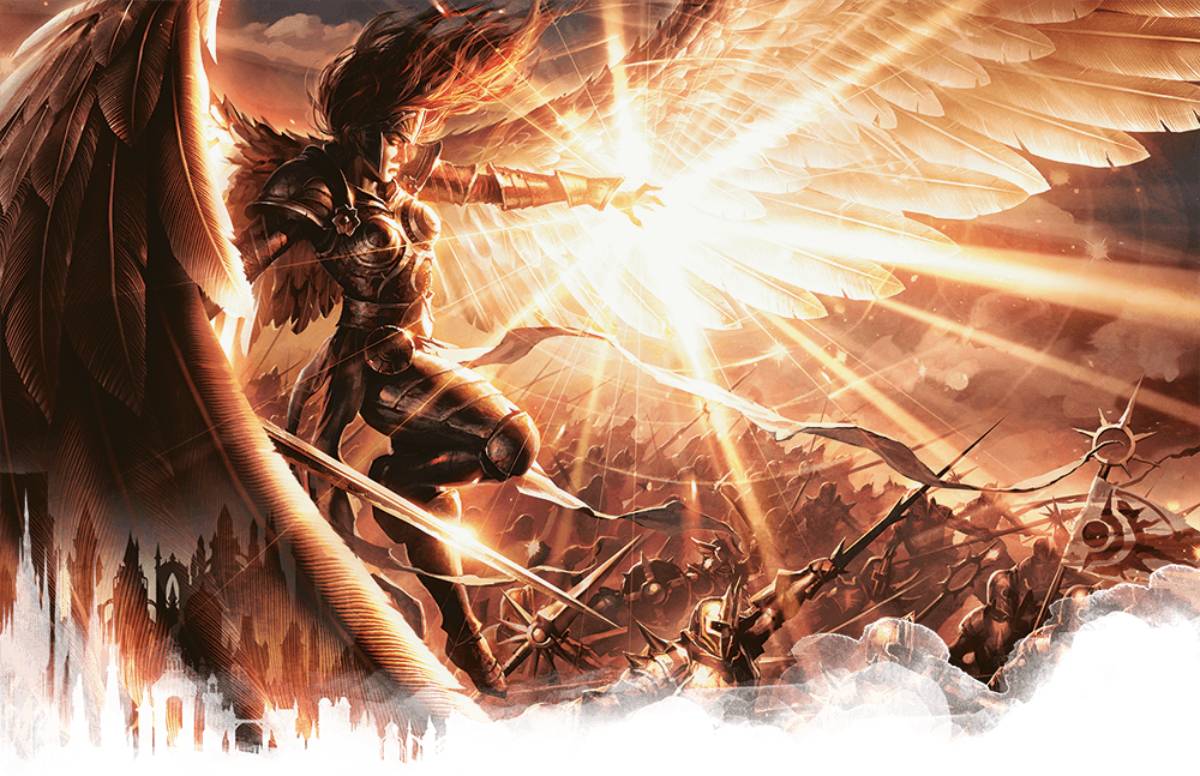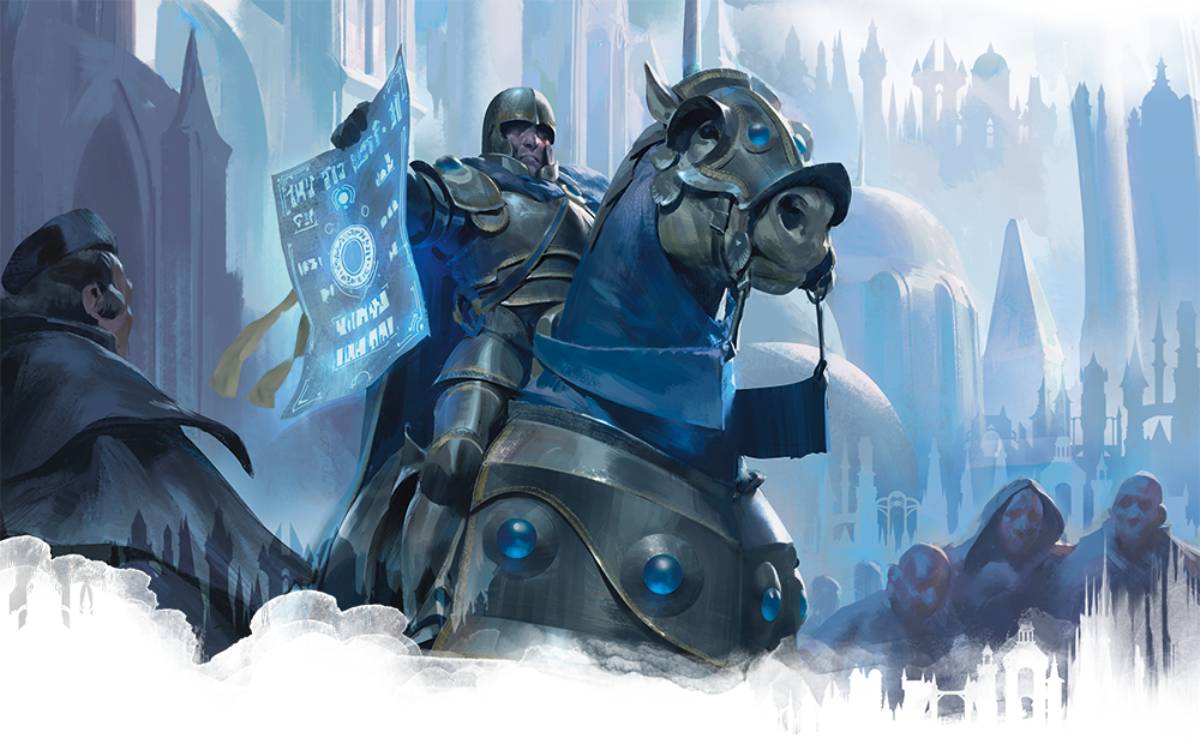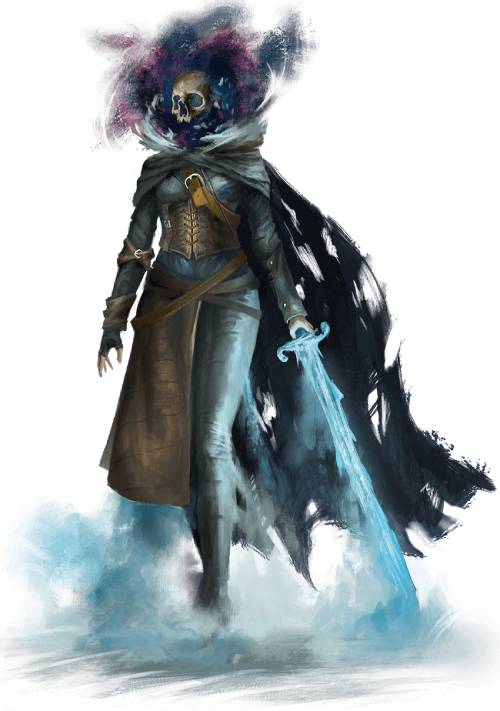Is your paladin a champion of the divine? A rebel with a cause? Whatever your oath or your motivations, you’ll be able to call upon divine magic to aid you in your adventures, whether you use it to slay monsters or support and protect allies.
Below, we review 10 of our favorite spells for the 2014 paladin:
- Aid
- Aura of Purity
- Bless
- Blinding Smite (and Other Smite spells)
- Destructive Wave
- Find Steed / Find Greater Steed
- Revivify
- Shield of Faith
- Spirit Shroud
- Zone of Truth
Half Casters With Divine Smite
Paladins are a “half caster;” they have fewer spell slots and a smaller spell list than their “full caster” counterpart, the cleric, but are much better with a sword. Half casters can only cast spells up to 5th level and don’t generally have access to cantrips, so this list will only feature spells of 1st through 5th level.
Paladins also have the powerful Divine Smite feature, which may affect the spells you choose to prepare. On any hit, you can choose to expend a spell slot to deal extra damage: 2d8 for a 1st-level spell slot, plus 1d8 for each spell level higher than 1st, to a maximum of 5d8. This is more damage per hit than any spell on your list (and you don’t need to risk concentration, nor does it cost action economy), so if your primary goal is to deal maximum damage, you’ll probably opt to smite most often.
1. Aid

2nd-level abjuration
As a paladin, you have the Lay On Hands class feature, which grants you a pool of hit points that you can draw from to heal yourself or others as an action. Use the aid spell to step in and do what Lay On Hands cannot: Heal multiple allies and increase their maximum hit points. At 2nd level, aid increases three creatures’ hit points, current and maximum, by 5. When upcast, the spell doles out 5 additional hit points for each slot above 2nd, meaning that by 9th level your paladin could be increasing most of your party’s hit points by 10 each. It doesn’t require concentration, meaning you can stack it with another buff spell that does, and it lasts for 8 hours. While the party is drinking their morning coffee and the arcane casters are donning their mage armor, give a few friends some aid.
No other paladin spell can increase a creature’s maximum hit points, so if you want to prepare one healing spell, this should be it. But you may have to decide who in the party to cast it on. Will you give it to the frontliners, who likely take the most damage but already have considerable hit points? Or to the fragile folks, so that they’re less likely to instantly fall unconscious after a single dragon’s breath?
2. Aura of Purity
4th-level abjuration
Imposing armored warriors can be support casters, too. In fact, if you’re carrying a thick shield and wearing heavy armor, enemies may find it quite difficult to break your concentration. Use this to your advantage with buff spells like aura of purity, which protects your party against several of the most common harmful conditions and grants everyone within its radius resistance to poison damage. Many monsters use poison-coated weapons or have venomous stings and bites, so you’ll appreciate this aura when you’re fighting giant spiders in the Underdark or green dragons in the forest.
An aura of purity will also help protect your party from a lich's Paralyzing Touch, an autumn eladrin's Enchanting Presence, and an ilithid's Mind Blast. No reports yet on whether it cures hangovers, but presumably the barbarians and bards of the world will let us know.
3. Bless
1st-level enchantment
A widely-known fan favorite, bless reminds us that oftentimes classics are classic for a reason. Nearly every table has a story about a time someone failed a saving throw that would have dropped them unconscious… until someone reminded them that they were blessed, and they escaped danger.
Bless boosts the luck of up to three creatures, granting them a bonus to attack rolls and saving throws. It’s a highly effective combat spell if you want to keep your allies alive and help ensure their attacks land. Plenty of people play a paladin as a martial damage dealer or tank, but with their high AC, they can also be effective support casters. Keep your shield high and your armor heavy, and enemies will find it quite difficult to break your concentration.
4. Blinding Smite (and Other Smite spells)
3rd-level evocation
While these smite spells may not be "divine," they can be effective in a wide range of scenarios. However, unlike the paladin's patented Divine Smite, these spells cost a bonus action and require concentration, but they impose an additional effect, such as the prone or frightened condition.
Blinding smite is my favorite of these smite spells. Blinding smite deals 3d8 radiant damage on top of your normal damage and blinds the target for 1 minute if they fail a Constitution saving throw. Attack rolls against a blinded creature have advantage, and the creature’s attack rolls have disadvantage.
Of the many smite spells to choose from, I favor this one because targets are less likely to be immune to the blinded condition than, say, the frightened condition, and the target cannot un-blind themselves on their turn as easily as they might stand up from being prone. Fortunately, a paladin can change their prepared spells daily, so you can tailor your smites to whatever monster you’re chasing or castle you’re storming.
5. Destructive Wave
5th-level evocation
Destructive wave is a paragon of evocation: It deals massive damage (including half damage on a successful saving throw) in a wide radius, doesn’t damage allies, knocks enemies prone, and its damage types—thunder and radiant or necrotic—can be tailored around enemy resistances.
Unfortunately, your paladin won’t be able to access this spell until 17th level, but it is a must-pick for high-level one-shots. Alternatively, your DM may be willing to make a spell scroll or spellwrought tattoo available as loot or a quest reward.
6. Find Steed / Find Greater Steed

2nd-level conjuration and 4th-level conjuration
Can the wizard’s familiar pull the party’s cart hundreds of miles? Or knock an opponent prone? Save the party quite a bit of gold with find steed and summon a spirit that takes the form of a beast such as a warhorse, mastiff, or elk. Your spirit steed is smarter than its natural counterpart, with an Intelligence of 6, can understand one language, and you maintain a telepathic connection to the steed as long as it is within 1 mile.
This spell has a major advantage over other summoning or conjuring spells: “While mounted on your steed, you can make any spell you cast that targets only you also target your steed.” Heal both yourself and your steed after the enemy’s fireball with just one cure wounds. Or buff yourself with heroism, protection from evil and good, shield of faith, or spirit shroud, and apply the spell to your steed for free! Remember that this effect would apply to spells that you cast from a magic item, so consider what shenanigans you could get up to with items like a wand of polymorph.
7. Revivify
3rd-level necromancy
The power to bring an ally back from death is highly sought after but rarely acquired. Only artificers, clerics, and paladins learn revivify as part of their class' spell list, so if you reach 9th level, you might want to make room for it. Even if your cleric has been casting this spell since the party reached 5th level, picking up this spell as a paladin means the party can now revive the cleric if they fall. Just remember to bring diamonds with you, as this spell consumes 300 gp worth of diamonds per casting.
8. Shield of Faith
1st-level abjuration
Shield of faith is a simple yet reliable defensive spell. It provides a +2 bonus to its target’s AC, allowing you to support an ally in a precarious position or cover gaps in your own armor before charging headfirst into a horde of enemies.
If you’re already buried in heavy armor and a shield, use this spell to make yourself downright unreasonably hard to hit. If you’re a Great Weapon Master or a Polearm Master, you’ve had to put down your physical shield to focus on offense and can use shield of faith to pick up the slack. And when a vulnerable party member is in danger of being smashed by the wrong end of a pit fiend’s mace, throw this spell their way to help keep them safe.
9. Spirit Shroud

3rd-level necromancy
The paladin spell list features plenty of ways to increase your damage output, but none come with all of the bells and whistles of spirit shroud. While the spell lasts, you’ll deal extra cold, necrotic, or radiant damage—a welcome influx of flexibility in a class that primarily focuses on radiant damage. Additionally, any creature of your choice that starts its turn within 10 feet of you has its speed reduced by 10 feet until the start of your next turn. But possibly most useful is its anti-healing ability: Any creature that takes this spell’s extra damage cannot regain hit points until the start of your next turn.
I recommend spirit shroud for its anti-regeneration effect, but if you need to focus on dealing as much damage as possible, holy weapon (for yourself or an ally) might be the way to go. If you’re surrounded by Undead or Fiends and your party just needs to hit monsters with radiant damage, look to the aura produced by crusader’s mantle.
10. Zone of Truth
2nd-level enchantment
Why rely on an Insight check when you can put your faith in magic? With zone of truth, you can take a more straightforward approach to mystery-solving.
This spell creates an area of effect that prevents creatures from speaking a deliberate lie if they fail a Charisma saving throw. The average NPC doesn’t have a high bonus to Charisma saving throws, so this spell is likely to succeed on many witnesses, informants, suspects, and henchmen. Keep in mind that everybody who is affected by this spell is aware of it, and can try to be evasive or refuse to answer any questions. Remember that some monsters are very experienced at talking around the truth, so cast this on creatures like Fey and devils at your own risk!
Building a Paladin
Time to take your magic on an adventure! Be ready to infuse your weapons with divine power, heal your allies, and keep the party safe. When you’re ready to roll for your stats and give your paladin a name, jump into D&D Beyond’s character builder!
Damen Cook (@damen_joseph) is a lifelong fantasy reader, writer, and gamer. If he woke up tomorrow in Faerun, he would bolt through the nearest fey crossing and drink from every stream and eat fruit from every tree in the Feywild until he found that sweet, sweet wild magic.








-
View User Profile
-
Send Message
Posted Jan 14, 2024This article refers to the current paladin as the 2014 version to take into account that the 2024 version might have a different spell list, even as the revised version will be backward compatible.
-
View User Profile
-
Send Message
Posted Jan 14, 2024Wow, its almost like you having to put a year in front to make the difference in the class due to 1D&D's changes known means that this "revision" isn't actually backwards compatible like was originally promised. Also, spirit shroud is from Tasha's, not 2014 PHB/SRD.
-
View User Profile
-
Send Message
Posted Jan 14, 2024Yeah, that's what people are confused/irritated over.
2014 Paladin sounds like it should be the 'base paladin' as released and shown in the 2014 PHB.
What they are actually discussing is the 5e paladin, with all official options and errata added over the past decade.
I get the need to differentiate, as we'll be getting a 'new' paladin this year, but the idea of referring to the old one by year instead of by edition seems weird (and confusing).
Which I believe says something about Wizards trying to move away from calling things by editions? I don't know...
-
View User Profile
-
Send Message
Posted Jan 14, 2024So it says “2014”’ and not “5e.” It’s just one article, folks. Don’t worry about it. You can still call the paladin whatever you like. Me, I call it “wannabe cleric.”
-
View User Profile
-
Send Message
Posted Jan 14, 2024Succinctly said - two thumbs up
-
View User Profile
-
Send Message
Posted Jan 14, 2024Is the Paladin’s name Slowpoke??
-
View User Profile
-
Send Message
Posted Jan 14, 2024I have been playing a hybrid 2014 and 2024 UA game since the UA was released and I have spoken with a number of other folks who have been playing hybrid games. Every single person who I have interfaced on this topic has come to the same conclusion - the two versions are going to be easily compatible.
2014 subclasses easily work with 2024 classes. 2024 spells and 2014 spells are interchangeable—though often you’d rather use the 2024 versions since they fix long-standing problems with 2014 spells (for example, increasing healing output of healing spells, which have never been action economy efficient due to monster damage far outstripping player healing). 2024 backgrounds not only work with 2014 rules—they have been in the game since Strixhaven, coexisting with the 2014 rules perfectly well, with no one realising the revised rules had already been released. 2024-style monsters and species have been existing compatibly with 2014 rules since MMM.
So, not only are people who actually have tried hybrid games saying hybrid games are pretty easy to run—the versions are so similar, many of you have been playing with hybrid rules for years without knowing.
-
View User Profile
-
Send Message
Posted Jan 14, 2024OMFG People. Can we get off of the whole 2014/2024 thing already?!? It’s not on topic here.
-
View User Profile
-
Send Message
Posted Jan 14, 2024Exactly. If people wanna complain about that, they can go make their own thread. We’ll wait.
-
View User Profile
-
Send Message
Posted Jan 14, 2024Dear Community team for DND Beyond: Your bosses hate you and want to replace you with computers. We don't hate you though.
-
View User Profile
-
Send Message
Posted Jan 14, 2024.
-
View User Profile
-
Send Message
Posted Jan 14, 2024100% agree! I hope everyone sees this post.
-
View User Profile
-
Send Message
Posted Jan 15, 2024I miss encounters of the week
-
View User Profile
-
Send Message
Posted Jan 15, 2024me too :(
-
View User Profile
-
Send Message
Posted Jan 15, 20242014 Paladin? 2024?
-
View User Profile
-
Send Message
Posted Jan 15, 2024Good grief, what a mess. I'll just gonna call it 5.5e.
-
View User Profile
-
Send Message
Posted Jan 15, 2024It's... literally in the article title. The only reason I even came to the comments was to see if someone had already pointed out the "editorial error" in the year....
-
View User Profile
-
Send Message
Posted Jan 15, 2024Yeah if they change even a fraction of what they're looking to change that ain't no 5e. It is a new edition.
You can't change as much as they are going to and just refuse to call it something new. It is so strange.
-
View User Profile
-
Send Message
Posted Jan 15, 2024Not really much different with what happened with 3e and 3.5e and eventually Pathfinder 1e. Things will be largely compatible, but the power creep will likely benefit the newer edition rather than the legacy edition. But I'm sure mostly everyone will call it 5.5e, but someone in Wizards thinks branding like this is a good idea.
Maybe they should set up a survey on what to call the 2024 edition. lol
-
View User Profile
-
Send Message
Posted Jan 15, 2024It is actually considerably different. The differences between 3 and 3.5 were relatively minor. Mostly just a collection of tweaks and errata.
For 5e, to whatever this new edition is, they're entirely redesigning classes, spells lists, the way magic itself is broken up, like... literally everything is changing.